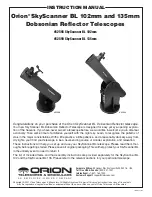
2
INTRODUCTION
A spotting scope is nothing more than a telescope that is designed to look around the Earth.
Unlike astronomical telescopes, which produce inverted or reverted images, spotting scopes
produce correctly oriented images. Celestron offers several different models, each of which uses
the highest quality optics to produce the best possible images.
How to Use this Manual
This manual explains the proper use of your Celestron spotting scope —from initial set up to on-
going use. This manual is broken down into several sections. The first covers attaching your
spotting scope to a stable platform, like a photographic tripod, so that the standard accessories can
be attached. The second section is on using your spotting scope. Topics include how to attach the
standard accessories, how to locate objects, etc. The last sections deal with general information.
Topics include visual and photographic observing hints, astronomical uses for your spotting
scope, and maintenance information. Before you attempt to use your spotting scope, read this
manual carefully.
A Word of Caution!
Your Celestron spotting scope is designed to give you hours of fun and rewarding observations.
There are, however, a few things to consider before using your spotting scope that will ensure
your safety and protect your equipment.
•
Never look directly at the Sun with the naked eye or with your spotting scope. Permanent and
irreversible eye damage may result.
•
Never use your spotting scope to project an image of the Sun onto any surface. Internal heat
build-up can damage your spotting scope and/or any accessories attached to it.
•
Never use an eyepiece solar filter or a Herschel wedge. Internal heat build-up inside your
spotting scope can cause these devices to crack or break, allowing unfiltered sunlight to pass
through to the eye.
•
Never leave your spotting scope unsupervised, either when children are present or adults who
may not be familiar with the correct operating procedures of your spotting scope.
•
Never point your spotting scope at the Sun unless you have the proper solar filter. When
using your spotting scope with the proper solar filter, ALWAYS cover the finderscope.
Although small in aperture, this instrument has enough light gathering power to possibly
cause permanent and irreversible eye damage. In addition, the image projected by the finder
is hot enough to burn skin and clothing.
Содержание 102mm
Страница 1: ...80mm Wide View Spotting Scope 52260 102mm Wide View Spotting Scope 52270 INSTRUCTION MANUAL...
Страница 15: ......


























